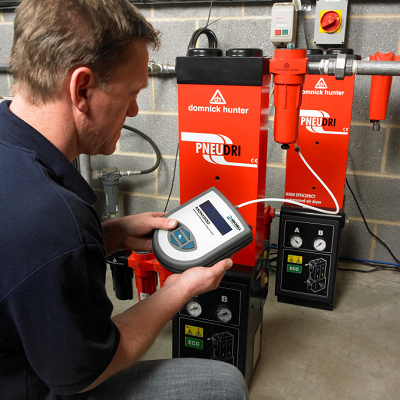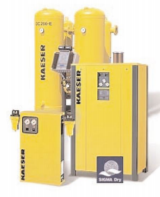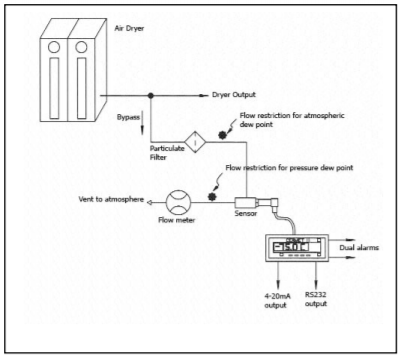Many manufacturing processes require a constant supply of compressed air. The air may be used for many different reasons; for example, the actuation and control of pneumatic valves, cylinders and controllers; operation of process machinery or tooling; as a transport medium for bulk materials; or as a purge gas.

Figure 1.The compressed air supply will contain some moisture which, if uncontrolled, could potentially cause damage to the process, pneumatic controls, tooling, finished product, or indeed the components of the air distribution system itself.
To reduce the likelihood of these problems occurring, compressed air supplies are often conditioned to remove or significantly reduce the moisture content before the air is consumed by the process.
Refrigerant dryers are commonly used to reduce the moisture content of compressed air. In principle the compressed air is cooled in a heat exchanger to a temperature just above the freezing point of water, causing much of the moisture in the air to condense out to liquid, which can then be drained off.
Efficient operation of the dryer is dependent on maintaining good temperature control at close to 32° F in the heat exchanger and upon the design of the heat exchanger itself. If the temperature drops below 32° F, ice will form on internal surfaces and dryer performance will be reduced. Refrigerant dryers are normally equipped with temperature-sensing devices to monitor the outlet air temperature. This measurement will give a first indication of the operation of the dryer, but does not guarantee the quality of the air at the dryer output. The only way to be certain that the dryer is functioning correctly is to measure the moisture content of the outlet air directly using an appropriate hygrometer.
Regenerative desiccant column dryers can offer a very efficient method of air drying. These dryers are normally configured in twin columns, allowing one column of desiccant to be regenerated while the other is performing the air drying process.

Figure 2: Example of a desiccant dryer.There are two common types: pressure swing and heat regenerative. A pressure swing dryer uses a sudden drop in pressure of the column under generation to evaporate moisture from the desiccant, which is then flushed out of the column to atmosphere by a back purge of air from the column under load.
In the case of heat-regenerative dryers, large electrical or steam heaters are used to regenerate columns of saturated desiccant material and in such cases energy efficiency is of prime importance. As the demand made on the dryer can be variable, it follows that it would be advantageous to control the dryer cycle period according to the output performance required, rather than simply on a fixed time interval, as is often the case.
By monitoring the moisture content of the common dryer outlet using a hygrometer, this information can be used not only as a quantitative measurement, but also to initiate the dryer cycle change-over point at a pre-determined moisture level. This system is often referred to as dewpoint demand system, and it provides the user with significant energy savings as well as a consistent quality of dry air output.
It is common for a portable hygrometer to be used for spot checking air quality where there are multiple usage points or long air line runs from compressor to working location. For online measurements, either a transmitter or hygrometer with display may be implemented, dependent on whether the user wishes to connect into a data acquisition system or simply provide a local display of the measured dewpoint. Increasingly, transmitters are used for this application, being easy to install, relatively low cost and offering a standard milliamp output signal that is suitable for input into a control system, which may actually control the function of the air dryer. Measurements may be made either at full line pressure or at atmospheric pressure, depending on preferred working practice. The diagram shows an example of an online hygrometer measuring the output of an air dryer after a particulate filter. Correct positioning of flow and pressure regulation will facilitate measurement at either line pressure or atmospheric pressure. A suitably ranged flowmeter after the sensor provides an ongoing indication that an adequate flow rate is achieved across the sensor.
The sampling arrangement for a portable hygrometer would be much the same, and Kahn Instruments can provide ready-made solutions for its portable hygrometers. An example of a suitable sampling system is shown here.

It is important that good sampling practice be observed in making these measurements. Sample tubing should be of good-quality stainless steel, preferably 1/8 in or 1/4 in outer diameter, with high-quality fittings. Tube lengths should be kept to a minimum to ensure fast response, and there should always be a tail-pipe after the sensor to ensure that back diffusion of ambient air does not compromise the measurement.
Filtration is also normally recommended for compressed air applications. Kahn offers a standard filter unit that provides particulate protection to 0.3 micron with an efficiency of 99.5%. Ready-made sampling systems are also available on request.
Which instruments?
Kahn Instruments can offer a variety of hygrometers that are suitable for the measurement or control of compressed air quality. The Easidew range of capacitive hygrometers provides simple online or portable measurement of compressed air dewpoint. The range includes three products, all based around the core Easidew Transmitter, which is a fully self-contained probe, powered by a 12 to 28 V DC input, and providing a linear milliamp output in Fahrenheit dewpoint. This transmitter can be used alone, providing an output into a controller or external monitoring system, or coupled with an easy-to-install display unit that provides transmitter excitation, digital display, milliamp output and a dual alarm.
Completing the range is the Easidew Portable, providing digital display and milliamp output, and featuring an integral rechargeable battery pack and a full sampling system with filtration, flow and pressure regulation. Easidew Transmitter and online versions give continuous measurement and the Easidew Portable is a convenient instrument for regular spot-checks at point of use of the compressed air.
Additionally, the Cermet II Hygrometer is a sensor and monitor combination with intelligent digital display that offers multiple engineering units, milliamp output, voltage and RS232 output options with up to four alarm contacts. The HygroPort Portable Hygrometer also offers multiple engineering units and features an in-built data-logger for storing up to 360,000 measurement points and a rechargeable battery system. Both the Cermet II and HygroPort can take an auxiliary pressure input for active pressure compensation if required.
Kahn also offers the Easidew IS Dewpoint Transmitter. This is a FM and CSA-certified instrument providing linear 4-20 mA output and is suitable for use in most hazardous-area applications, such as hydrogen and natural gas dryers.
https://insights.globalspec.com/article/12543/measurement-and-control-of-compressed-air-systems